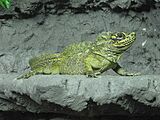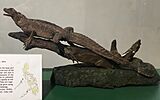Philippine sailfin lizard facts for kids
Quick facts for kids Philippine sailfin lizard |
|
|---|---|
 |
|
| Wild Philippine sailfin lizard in Leyte | |
| Conservation status | |
| Scientific classification | |
| Genus: |
Hydrosaurus
|
| Species: |
pustulatus
|
The Philippine sailfin lizard, also called the Philippine sailfin dragon, is a large lizard. It lives both on land and in water, and is found only in the Philippines. You won't find them in the Palawan islands, though. These lizards are special because they have a cool, sail-like fin on their backs and tails.
They can grow up to 3 to 4 feet long (about 1 to 1.2 meters). Philippine sailfin lizards are amazing swimmers. Young lizards can even run across the water for a short time! They live in thick plants near coasts and rivers, especially in mangrove forests. In the Philippines, people call them layagan or balubid in Tagalog. In the Visayan languages, they are known as ibid.
This lizard is a protected animal in the Philippines. People sometimes try to catch them for the international pet trade. Their unique crests and bright colors make them popular. Losing their mangrove forest homes is also a big problem for them.
Contents
About the Philippine Sailfin Lizard
The Philippine sailfin lizard's scientific name is Hydrosaurus pustulatus. It was first described in 1829 by a scientist named Johann Friedrich von Eschscholtz. He found these lizards in Luzon, Philippines. This happened during a Russian trip around the world from 1823 to 1826.
This lizard is one of five types of "sailfin dragons" in the Hydrosaurus group. It is the only type found in the Philippines. The other sailfin dragons live in Indonesia and Papua New Guinea.
Scientists have found that Philippine sailfin lizards look different depending on where they live. Their colors and scale patterns can change a lot. A study in 2014 showed there are six different groups of these lizards. The ones from Aurora in Luzon and the Polillo Islands are the most unique.
Where Philippine Sailfin Lizards Live
You can find the Philippine sailfin lizard all over the Philippines. The only place they are not found is the Palawan islands. They have been seen in many areas, including Luzon, Polillo Islands, Samar, Leyte, Mindanao, and more.
These lizards like to live in tropical forests close to water. This includes rivers, riverbanks, and even rice fields. They especially love mangrove forests. They prefer to live near fresh water. You can often find many of them living together in these areas.
Appearance and Behavior
Philippine sailfin lizards are large. They usually grow to be two to three feet long, including their tail. Male lizards are bigger than females. Males can grow up to 3 to 4 feet long (91 - 120 centimeters). These lizards usually weigh between 3 and 5 pounds (1.4 - 2.3 kg).
The Sailfin Crest
A special part of this lizard is its crest, or sailfin. This is an upright part of its body that goes from its tail to its lower back. This crest helps the lizard swim well in water. It also helps them show off to other lizards, especially during mating season. The crest can also help them warm up or cool down in different places. This crest makes the lizard's body look like a sail. The rest of their body and tail are mostly round.
Running on Water
Young Philippine sailfin lizards are excellent swimmers. They have flat toes and are lighter than adults. This allows them to run across the water, much like basilisk lizards. Adult lizards usually lose this ability as they get heavier. However, their flat toes still help them swim very well. These flat toes also have special scales that help with swimming and running on water.
Differences Between Males and Females
Male lizards have a bigger crest on their back than females. Males also have larger heads and taller sails on their tails. Their limbs are often darker. During mating season, the male's head turns violet. Only the neck area of a female's crest might turn violet. Philippine sailfin lizards usually have dark green and brown skin. They can also have yellow spots on their backs and near their heads.
Staying Safe
The Philippine sailfin lizard has a flat tail. This helps it move quickly in water to escape predators. If a predator is near, the lizard might drop from a tree branch. It can also run or swim to the bottom of the water. They can hold their breath for up to 15 minutes!
These lizards are active during the day. They spend most of the daytime resting in plants under the sun. They use running to move around their homes and to get away from danger. Philippine sailfin lizards can live for 10 to 20 years. They also have a special "third eye" on top of their head. This eye can sense light from the sun. Scientists think it helps them find their way around.
Life Cycle and Reproduction
Philippine sailfin lizards use their sailfins and scales to show off to other males or when they feel threatened. They breed once a year and can lay several groups of eggs.
After mating, female lizards dig shallow holes in the soil near water. They lay their eggs in these holes. The eggs stay in the ground for about two months. The baby lizards hatch during the rainy season. These hatchlings are born very quick and agile. They can run across the water to escape predators, unlike the adult lizards who swim. Female lizards can lay between 2 and 8 eggs in each group. They always lay their eggs above the flood line, so they don't get washed away.
Conservation Efforts
The Philippine sailfin lizard is listed as "Least Concern" by the IUCN. However, they are becoming more at risk. Their biggest threats are losing their homes, being hunted for food, and being caught for the pet trade.
Losing their habitat is a very serious problem. Only about 7.5% of the mangrove forests in the Philippines are in protected areas. Over the last 75 years, 75% of the Philippines' mangrove forests have been lost. This is mainly because land is being used for cities and fish farms.
Philippine sailfin lizards are a protected species in the Philippines. It is against the law to catch them from the wild. It is also illegal to take them out of the country. These lizards were sold a lot between 1980 and 1990, before it became illegal. But there is still an illegal trade for them. Studies have shown that many lizards sold illegally in Manila were caught from the Bicol Region. Other places where they are illegally sold include Puerto Princesa, Cebu, and Davao.
What They Eat
Philippine sailfin lizards are omnivores. This means they eat both plants and animals. They eat plant leaves and fruits. They also eat insects and small crabs. Young lizards prefer to eat more meat than plants. As they get older, their diet becomes more balanced.
Their diet is easy to copy, which is why people want them as exotic pets. However, they are not as calm as some other lizards. Their teeth also show they are omnivores. Their back teeth are not designed for eating only meat.
Keeping Them in Captivity
If someone keeps a Philippine sailfin lizard as a pet, they need a very large space. This space should have tropical heating and places for them to climb. They also need access to water where they can swim. This helps to copy their natural home.
Breeding these lizards in captivity has only happened a few times. But some people pretend to breed them to illegally smuggle them out of the Philippines. Since these lizards are common in many parts of the Philippines, the illegal pet trade still happens. Some of these trades are not even known by the government.
It's important to be careful around captive Philippine sailfin lizards. They can be very nervous and might scratch people. However, studies show that hand-feeding them can help them become less nervous and trust people more.
Gallery
- Philippine Sailfin Lizard
-
Philippine sailfin lizard at Bristol Zoo
-
Philippine sailfin lizard in Tropicario in Helsinki, Finland
-
Living specimen at the San Diego Zoo






